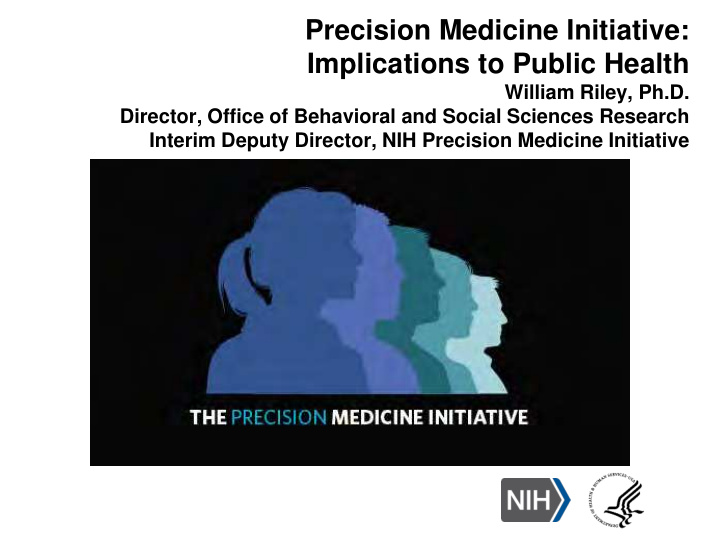



Precision Medicine Initiative: Implications to Public Health William Riley, Ph.D. Director, Office of Behavioral and Social Sciences Research Interim Deputy Director, NIH Precision Medicine Initiative
Research Methods in a Data Poor Environment • Priority is on prospective design and data collection • Limited data collection opportunities • Predominately cross-sectional or minimally longitudinal designs • Unable to assess or control myriad confounds • Control confounds via randomization
Research Methods in a Data Rich Environment • Temporally Dense • Computational • Predictive
A Brief History of a Data Rich Science: Meteorology • Local, limited measurement • Leverage communications technologies (telegraph) to connect data across sites • Set standards for data integration • Continued leveraging of technical advances in measurement and communication • Result: Rich, integrated data computationally modeled to explain and predict phenomena Is it possible for health research to become a data rich science?
Dawn of a Data Rich Behavioral Science Ecological Momentary Assessment (EMA) methods improved and delivered on cell phones Capture of “digital breadcrumbs” from daily interactions with technology Social media Call data records Consumer sensors Sensors that can passively and continuously monitor health risk behaviors in context Physical activity sensors Smoking sensors Sun exposure sensors Environmental exposure sensors Dietary intake sensors (sort of) Applications of computational modeling and new statistical modeling approaches that provide the analytic capabilities for intensive longitudinal (temporally dense) data. 5
“And that’s why we’re here today. Because something called precision medicine … gives us one of the greatest opportunities for new medical breakthroughs that we have ever seen.” President Barack Obama January 30, 2015
www.nih.gov/precisionmedicine
Public Health Less than Enthusiastic about Precision Medicine “We worry that an unstinting JAMA, June 2015 focus on precision medicine… is a mistake — and a distraction from the goal of producing a healthier population.” Bayer and Galea, NEJM, 2015
• more than genes, drugs, and disease • reasonable hypothesis that subgroups characterized by their behavioral and environmental exposures may respond differentially to treatments • advances beyond self-report of behavioral and environmental factors (e.g., technologies) • participant engagement underpinnings in science of motivation and learning Translational Behavioral Medicine, 2015; 5:243-6
“providing the right intervention to the right population at the right time” “use of information technology and data science in enhancing public health surveillance”
Multiple Levels of Influence 8 Glass & McAtee, 2006, Soc Science Med
PMI: National Research Cohort Will comprise: – >1 million U.S. volunteers – Health Provider Organizations (HPOs) – Direct Volunteers Participants will: – Be centrally involved in design, implementation – Be able to donate biological samples, healthcare records, longitudinal self-report and sensor data – Receive regular feedback on the data they donate Will forge new model for scientific research that emphasizes: – Engaged participants – Open, responsible data sharing with privacy protections
A TRANSFORMATIONAL APPROACH TO PARTICIPATION Participants in the PMI Cohort Program will be true partners— not patients, not subjects—in the research process Involved in every step of program development • What data we collect • What lab analyses we do • What research is conducted • How data gets returned
A TRANSFORMATIONAL APPROACH TO DIVERSITY The cohort will reflect the rich diversity of America to produce meaningful health outcomes for subpopulations traditionally underrepresented in health research (across race/ethnicities, across socioeconomic status, across geographic areas).
A TRANSFORMATIONAL APPROACH TO DATA ACCESS • Rapid data sharing both to researchers and participants • Data collection will start small and will grow over time • Privacy and security will adhere to the highest standards • Will invest to level the playing field so diverse researchers can benefit
TWO METHODS OF ENGAGEMENT Healthcare Provider Direct Volunteers Organizations
PMI COHORT PROGRAM DATA • The Program will start by collecting a limited set of standardized data from sources that will include: • Participantprovided information • Electronic health records • Physical evaluation • Biospecimens (blood and urine samples) • Mobile/wearable technologies • Geospatial/environmentaldata • Data types will grow and evolve with the science, technology, and participant trust. • Tiered approach (not all data from all participants)
PROGRAM INFRASTRUCTURE • Data and Research Support Center (DRC) – Vanderbilt University Medical Center, with the Broad Institute and Verily • Biobank – Mayo Clinic • Participant Technologies Center (PTC) – Scripps Research Institute, with Vibrent Health • Healthcare Provider Organizations (HPOs) • Regional Medical Centers • Community Health Centers (e.g., Federally Qualified Health Centers) In collaboration with community and federal • VA Medical Centers partners, provider groups, and others
Patient Partnerships EHRs Technologies Genomics Data Science
Recommend
More recommend